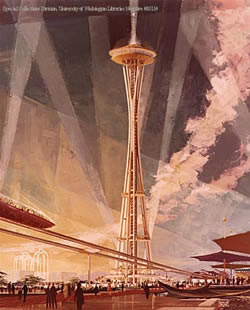
Lesson Twenty-five: The Impact of the Cold War on Washington,
The 1962 Seattle World's Fair
An artist's conception of the Century 21 Seattle Space Needle (left). (Special Collections, University of Washington, neg. #10114. Drawing by Earle Duff. Copy by Yang Color Photography, Seattle.)
In 1909 the city of Seattle had hosted the Alaska-Yukon-Pacific Exposition, a world's fair whose name called attention to the city's economic orientation, especially its command over (or designs on) hinterlands to the north and trade across the ocean. In 1955, the civic leaders of Seattle proposed another world's fair for 1959, to mark the 50th anniversary of the A-Y-P Exposition. Initially, proponents of the fair were not sure what theme to use. Moreover, events beyond their control delayed the fair three years beyond the original suggested date. But when Seattle's second international exposition opened in 1962, the first major American fair since before World War II, it reflected the city's economic orientation as fully as the 1909 fair had. The themes were space, science, and the future, as reflected in the signature building (the Space Needle), the largest attraction (the U.S. Science Exhibit, which later became the Pacific Science Center), and the name of the fair (the Century 21 Exposition, implying a look at what life in America would be like in the year 2000 and beyond). These themes mirrored the city's economic participation in American mobilization for the Cold War. By building jets and missiles and spacecraft, The Boeing Company had put Seattle on the map in new ways and given it an identification with scientific and technological innovation. The city was in many ways an ideal place to hold what became known as "America's Space Age World's Fair." [An introduction to the fair is John M. Findlay, Magic Lands: Western Cityscapes and American Culture after 1940 (Berkeley: University of California Press, 1992), ch. 5.]
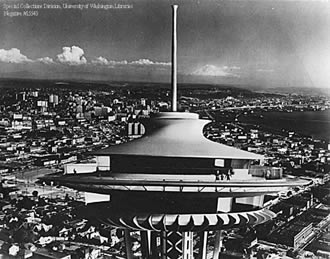
Typical of the themes of the fair was the 600-foot Space Needle, the structure that became as synonymous with Seattle as the Eiffel Tower was with Paris. Conceived and built by private interests, the Space Needle adhered to the themes of science and space in virtually all details. High speed elevators, designed to resemble "space capsules with large vision ports," carried guests up to the observation deck and a revolving restaurant that was said to resemble a flying saucer and was lighted at night so as to seem to be hovering in the sky. Dining hostesses wore "skin-tight gold coveralls" meant to resemble space suits. And the color scheme of the building exterior was, literally, out of this world: "astronaut white, galaxy gold, re-entry red and orbital olive." The Space Needle summarized the orientations of Century 21.
A view of the Century 21 Seattle Space Needle looking towards the downtown (right) area whose interests the fair was to promote. (Special Collections, University of Washington, neg. #15543.)
The Seattle Monorail, c.1980 (below). (Special Collections, University of Washington, neg. #13107.)
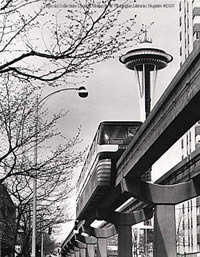
The 1962 world's fair was in large part a monument to Boeing and its influence on the urban area. It is therefore paradoxical that the businessmen, politicians, and journalists who initially conceived, promoted, and planned the exposition during the mid-1950s were actually quite concerned that Boeing was having too much influence on the city. The leaders behind the Century 21 Exposition came primarily from downtown Seattle. They were men (for the most part) who felt that Boeing was too dominant in the local economy; that the city needed to diversify by advertising itself nationally and attracting new businesses and more tourists to town; that the expansion of Boeing, by accelerating the suburbanization of Seattle, was helping to drain economic vitality from downtown; and that Seattle's central business district (or CBD) could be revitalized by adding cultural facilities, better transportation access, and improvements to the main shopping areas. For these civic leaders, the world's fair was in large part a tool to help shape urban change so that downtown Seattle could hold its own in the face of sprawling suburbs, burgeoning shopping centers, and the thriving Boeing company. [On the urban agendas behind Century 21, see John M. Findlay, "The Off-Center Seattle Center: Downtown Seattle and the 1962 World's Fair," Pacific Northwest Quarterly 80 (Jan. 1989): 2-11.] The fair was also expected to call more national and international attention to Seattle. Like the boosters of the A-Y-P Exposition in 1909, the boosters of the 1950s felt that the world did not sufficiently appreciate Seattle or its postwar expansion and new maturity. Century 21, like the A-Y-P, was expected both to advertise recent growth and spur even more growth.
Seattle's downtown boosters attained some but not all of their goals. The city did become better known and attracted some new business during the early 1960s, for which the fair deserves some credit. Promoters of the exposition were able to locate the fairgrounds rather close to the CBD, and after 1962 the site became the Seattle Center, an important gathering place and cultural focus for the metropolitan area. The Center was able to add something to the nearby downtown. However, because the Center was located about a mile away from the retail core of the CBD, it never provided as much of a boost as planners had desired. For example, it had been proposed that the Center would become home to the growing convention trade in Seattle, but it proved too distant from downtown hotels, restaurants, and stores. So in the early 1980s, when the city and state decided to erect a new convention facility, they rejected a Seattle Center site and instead put the Washington State Convention Center downtown, over the freeway. A new symphony hall and A Contemporary Theater similarly rejected Seattle Center sites in the 1990s and headed for downtown. Another example of the failure of the downtown vision for the fair is the Monorail. When constructed in 1961-62 between the fairgrounds and the CBD, the Monorail was supposed to be the beginning of a new transit system focused on downtown and capable of bringing workers and shoppers to the CBD more easily. But the Monorail was not expanded beyond the original one-mile stretch. Today it strikes one more as a quaint relic from an earlier time than as the basis for tomorrow's mass-transit system.
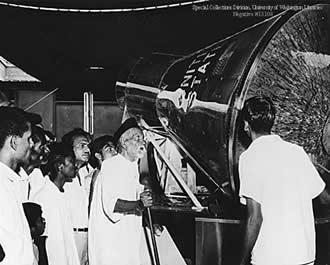
Perhaps the most noteworthy "failure" of Seattle's fair planners, however, was their inability to keep Boeing (and what Boeing stood for) from dominating the themes of the fair. In this respect, Seattle was no more immune from Cold-War influences than any other part of the Pacific Northwest. When civic leaders first conceived of a second world's fair for Seattle, they had talked about its prospective benefits for downtown and imagined sponsoring a "Festival of the West." But they were not really sure what kind of theme would prevail at the exposition. Then in October 1957 the matter was decided for them when, in one of the crucial moments of the Cold War, the Soviet Union launched Sputnik I, the world's first artificial satellite. The United States and Soviet Union had for years been developing missile systems to deliver weapons through space; Sputnik raised the stakes, and made the competition much more public. The race into space was under way, and Americans were desperate to respond to Sputnik in ways that reassured the nation and the world that the United States was not really "behind" the Soviet Union in the realms of science and space.
That science was perceived as a "universal language" is shown in this view of astronaut John Glenn's Friendship 7 (right), which was part of the fair's NASA exhibit. (Special Collections, University of Washington, neg. #13108)
In 1958 American statesmen, scientists, and politicians thus seized upon Seattle's proposed world's fair as one vehicle for responding to the challenges presented by Sputnik. The federal government decided to invest heavily in the exposition. Through the efforts of Senator Warren Magnuson, it spent about $10 million on an elaborate facility called the U.S. Science Exhibit. This exhibit displayed American advances in science and space. One portion of the federal building was a simulated ride to outer space, sponsored by The Boeing Company. The prominent participation of Boeing, a major supplier to the U.S. Department of Defense, was assured. Because 1962 was a busy year for the aerospace firm, the very first page of the Official Guide Book to the fair was an advertisement inviting visiting engineers and scientists to stop by Boeing's employment information center on the fairgrounds. The space race came to Seattle in tangible fashion in August of 1962 when astronaut John Glenn's Mercury space capsule, the Friendship 7, went on display at the fairgrounds. The Friendship 7, the first manned American spacecraft to orbit the earth, was warmly received.
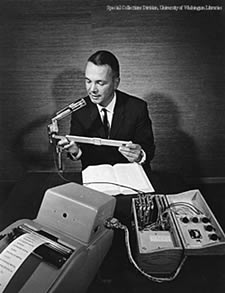
At the IBM exhibit (left), the engineer William Dersch demonstrates "shoebox," an experimental voice recognition device. (Special Collections, University of Washington)
Along with the themes of science and space, the idea of the future also came to permeate the exposition. The state of Washington hosted an exhibit called the World of Tomorrow. Devoted to predicting life in the year 2000, this exhibit meant to display how science and technology would change and improve living conditions. In short, a fair originally conceived as a "Festival of the West" had become America's Space Age World's Fair. By 1962, many national needs concerning the Cold War and space race had overridden the initial objectives of downtown leaders. But few complained, because the nation's and the world's attention to the new set of themes and ideas gave the Century 21 Exposition more popularity and a higher profile than it otherwise would have had. Moreover, most residents of the metropolitan area, quite conscious of the local economy's orientation to science and space, no doubt felt quite comfortable with the way the fair evolved. It just made sense to celebrate science and the space age in Boeing's hometown, and to portray Seattle as a headquarters of sorts for the Space Age.
The comments of scientists and legislators illuminate how the Seattle fair was reshaped to serve national needs during the Cold War. In hearings on U.S. participation in the exposition, congressmen, boosters, and technical experts explained that America's "very survival during the next century depends upon how well we develop our scientific resources." A federally sponsored exhibit on science at the fair would help by encouraging young people to take up careers in science. It would also reassure adults by serving as "a giant showcase where the American taxpayer can see graphically and at first hand where his money is going and why it is being spent." Moreover, fair messages would be targeted as well at other nations, especially the "undecided people" of the world, who presumably had to choose between the Soviet Union and the United States and would look to the fair for cues.
The Cold War was fought at least partially in the realm of public relations, and a world's fair proved to be an ideal opportunity to promote assorted American interests. To some extent, the messages presented were firm and even harsh. The legislation authorizing federal spending on a science exhibit specified that "no Communist de facto government holding any people of the Pacific Rim in subjugation" would be invited. The act barred North Korea, North Vietnam, and the People's Republic of China from participating (although the Soviet Union and Communist countries in eastern Europe were invited). In a similar vein, George Meany, president of the AFL-CIO, attacked the Soviet Union in a Labor Day speech by contrasting Seattle's new Space Needle, "a towering monument to the aspirations of humanity for a better life," to the Berlin Wall separating East and West Germans, which stood for "the basic cruelty of the Communist conspiracy and its utter disregard for human life and human values."
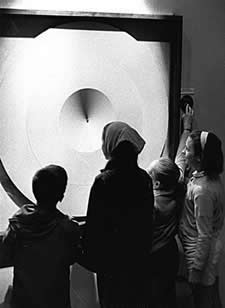
The U.S. Science Exhibit (right), entitled "Illusions." (Special Collections, University of Washington. Photo by Dudley, Hardin and Yang, Seattle.)
In the end these sharper notes were muted by the kind of optimism more commonly associated with world fairs. Scientists is particular hoped to avoid replicating in their displays the more negative aspects of competition between the superpowers. They spoke about science as a "universal language" drawing diverse peoples together and revealing new findings that would benefit all. The American biologist Jonas Salk found in the fair's scientific theme evidence that "the world is one culture." Moreover, there was widespread confidence that science would bring about improvements that would ultimately minimize world tensions. Science, it was said, would contribute to peace by helping to create the abundance that would make wars unnecessary. It could achieve this goal because it heightened people's mastery over nature and the universe. Scientific knowledge, the Official Guide Book explained, "enables man to harness nature's forces, to ease the burdens of living and lengthen the span of life. As it increases, man's ability to act, to mold and control his environment, will increase."
In a state and region where dams "tamed" the Columbia and Snake rivers, nuclear reactors "harnessed" the power of the atom, and Boeing produced jets and rockets that "mastered" the earth's atmosphere and outer space, the idea of science and technology providing tools to control nature and shape the environment doubtless went over very well. Visitors to the fair surely appreciated the different images of life and travel in outer space, but they may well have been even more captivated by suggestions about what scientific and technological advancement would mean to them on a daily basis on earth. The Century 21 Exposition had no shortage of suggestions for how "average" Americans could expect to benefit from the advances of the space age. Agribusiness and timber companies touted the maximization of harvests in the 21st century through the use of pesticides, chemical fertilizers, and more elaborate technology. Communication companies predicted advances in computers and electronics. Transportation companies conjured up visions of automated highways and high-speed cars. Three different exhibitors erected versions of the "home of tomorrow," complete with push-button conveniences and prefabricated, easy-to-add modular rooms. At bottom, the planners and designers of Century 21 assumed that a beneficent capitalism (as opposed to an unworkable communism) would ensure that scientific and technological advances reached eager consumers the world over. "The folks in Puyallup, Punjab and Peru are hungry for what we produce as living standards go up everywhere."
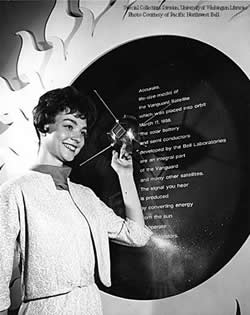
Bell Systems Exhibit (left). In its press release for this Century 21 photograph, officials from the Bell System laboratories wrote the following: A full- sized model of the United State's first satellite, Vanguard I, is a part of the Bell System exhibit.... Hostess, Linda Colwell explains how two Bell laboratories inventions -- solar batteries and transistors -- contributed to Vanguard I's success. The satellite's dependable voice -- still operating more than 4 years after it was placed in orbit -- is expected to continue through its estimated lifetime of some 200 years. (Special Collections, University of Washington. A Pacific Northwest Bell photo.)
In its optimism and its assumptions about growing affluence and consumerism, the Century 21 Exposition differed little from most world's fairs, which always have tended to look at the present and future in positive ways. But Seattle's 1962 fair reflected not just the customary tenor of international expositions but also the thinking of the decade in which it was conceived and planned, the 1950s. Those who planned exhibits for Century 21 envisioned a life that would be more affluent and fast-paced and automated than their own, but not fundamentally different. They did not foresee imminent social and cultural and political changes and as a result their forecasts of the future frequently proved outdated. One shortcoming was the fair's inattention to, and assumptions about, women. Exhibits at Century 21 foresaw no changes in relations between the sexes—women still did the majority of domestic tasks in all the houses of the future, and appeared to be charged with making their home a haven from the changing technologies on the outside. Many publicists for the fair, furthermore, worried that the emphasis on science and space would not appeal to women. So, they emphasized that their would be fashion shows and other attractions "for the ladies," while men visited the science exhibits and toured the space age. Century 21 was conceived and designed in the days before its sexist ideas were challenged by the rise of feminism. Betty Friedan's The Feminine Mystique (1963), the book that would help launch the women's movement, would not be published until the year following the fair. The exposition's optimism about world peace was abruptly shattered, too. President John F. Kennedy had agreed to visit Seattle for closing ceremonies in mid-October of 1962, but he cut short his cross-country trip and returned to the White House, where he set about managing the Cuban Missile Crisis.
Below: General Motors Exhibit. "The space-age motif which guided design everywhere at Century 21 led to the suggestions that the cars of tomorrow, including the General Motors Firebird III would be shaped like rockets. What mattered most in 1962 was how fast and how stylishly one traveled--not how much fuel was consumed or how much pollution was produced." (Findlay, Magic Lands, Berkeley, 1992, p. 247. Special Collections, University of Washington, neg. #1540)
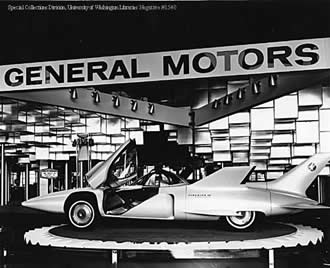
In some ways the Seattle World's Fair was obsolete almost as soon as it was over. What we might call the 1950s—a decade of confidence about economic abundance, American power, and the potential of science and technology—gave way to another era that we might call the 1960s, a period of rising political and social tensions, when it became clear that both American power overseas and the ability of science to solve problems had definite limits. This was nowhere more plain than in the nation's increasing concern about the environment. The Seattle World's Fair was predicated on the idea of mastering nature, even nature in the form of outer space. It celebrated such advances as synthetic fertilizers and virulent pesticides, faster cars and jet planes, without questioning their impact upon the world's ecosystems. This attitude, like the attitude toward women's place in society, would be challenged during the 1960s. Indeed, the publication of Rachel Carson's Silent Spring in 1962 (too late for fair planners to take heed of) suggested that the tide was beginning to turn. By the time the city of Spokane hosted its own world's fair a dozen years later, the theme would be protecting—not mastering—the environment (see Lesson 26).
As for Seattle, is was changed by the fair in a variety of ways. Those who had promoted an international exposition as a way to reshape the urban core got some of the benefits they had sought, especially national attention, increased tourism, a much better nucleus of facilities for the arts, and a substantially enriched cultural scene. The Space Needle survived, and became Seattle's best-known landmark. The Washington State Coliseum, built to house the state's exhibit for the fair, was left behind and became home to the city's first big-league sports franchise in 1967, the SuperSonics of the National Basketball Association (like the Space Needle, the team name is another relic of the Space Age celebrated at Century 21). Seattle had attained "major-league" status, both literally and figuratively. The Century 21 Exposition had helped gain for it more national attention, so that it stood more as an equal to the nation's other big cities. [On how Seattle's rise in this period set it apart from (and "above") Portland, see Carl Abbott's fine article "Regional City and Network City: Portland and Seattle in the Twentieth Century," Western Historical Quarterly 23 (Aug. 1992): 293-322.] But the world's fair hardly solved all the problems of downtown Seattle, or reversed the flow of people, jobs, and shops to the suburbs. Moreover, most of the problems it had been meant to address were soon overshadowed by new and more compelling ones, including the matter of civil rights and the question of environmental quality. The world's fair emerged at a time when economic growth and demographic growth were assumed to be good things in and of themselves, as they had been for more than a century in the American Northwest. These premises increasingly came into question after 1962, as issues that turned around quality of life rather than quantity of growth commanded more attention.
| Course Home | Previous Lesson | Next Lesson |